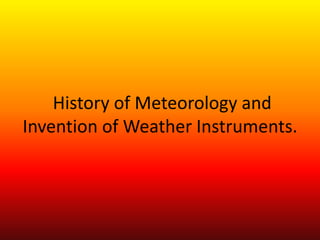
Presentatiomerriam
- 1. History of Meteorology and Invention of Weather Instruments.
- 2. History of meteorology The word ‘meteorology' was coined from a research book called ‘Meteorologica' which was written by Aristotle, a Greek scientist and philosopher. This early work described the science of earth like its geology, elements, hydrology, seas, wind and weather. In the modern term, the term meteorology explains a complete science. It is for understanding the dynamics of atmosphere and forecasting weather phenomena like hurricanes and thunderstorms.Weather forecasting was practiced since the beginning of time with more or less accuracy. Historical records show several examples of weather predicting methods based on observing surrounding elements.Sky is undoubtedly the first indicator used in meteorology its cover and nature of clouds provides clues of the upcoming temperature and weather. The wind factor is also important and is associated with temperature and often rains. Animals and birds are also known to give indications about the future weather.Scientists across the world since ancient times have tried to understand the meteorological phenomena like wind and rain. Many instruments for measuring wind power, humidity and rain were invented in the early 15th century.
- 4. thermometer is a device that measures temperature or temperature gradient, using a variety of different principles. The word thermometer is derived from two smaller word fragments: thermo from the Greek for heat and meter from Greek, meaning to measure. A thermometer has two important elements: the temperature sensor (such as the bulb on a mercury thermometer) in which some physical change occurs with temperature, and some means of converting this physical change into a value (such as the scale on a mercury thermometer). Industrial thermometers commonly use electronic means to provide a digital display or input to a computer.
- 5. weather radio service is a broadcast service which airs special weather-related emergency broadcasts and announcements. Weatheradio services may also broadcast non-weather related emergency information, such as in the event of a natural disaster, an AMBER alert or a terrorist attack. They generally broadcast in a preallocated VHF frequency range using FM. Usually a dedicated weather radio receiver or radio scanner is needed for listening, although in some locations a weatheradio broadcast may be retransmitted on a conventional AM or FM frequency, some terrestrial television stationsbroadcasting in MTS stereo transmit weather radio on their second audio program (SAP) channel as well as on one of its digital subchannels(where news and weather are applicable), on local public-access cable channels or during Emergency Alert System activations for tornado warnings primarily on cable systems.
- 6. barometer is a scientific instrument used in meteorology to measure atmospheric pressure. It can measure the pressure exerted by the atmosphere by using water, air, or mercury. Pressure tendency can forecast short term changes in the weather. Numerous measurements of air pressure are used within surface weather analysis to help find surface troughs, high pressure systems, and frontal boundaries.
- 7. anemometer is a device for measuring wind speed, and is a common weather stationinstrument. The term is derived from the Greek word anemos, meaning wind. The first known description of an anemometer was given by Leon Battista Alberti around 1450[1]. Anemometers can be divided into two classes: those that measure the wind's speed, and those that measure the wind's pressure; but as there is a close connection between the pressure and the speed, an anemometer designed for one will give information about both.
- 8. Hygrometer is an instrument used for measuring the moisture content in the environmental air, or humidity. Humidity is difficult to measure accurately. Most measurement devices usually rely on measurements of some other quantity such as temperature, pressure, mass or a mechanical or electrical change in a substance as moisture is absorbed. From calculations based on physical principles, or especially by calibration with a reference standard, these measured quantities can lead to a measurement of humidity. Modern electronic devices use temperature of condensation, changes in electrical resistance, and changes in electrical capacitance to measure humidity changes.
- 9. rain gauge (also known as a udometer or a pluviometer [Pluviograph ] or anombrometer or a cup) is a type of instrument used by meteorologists and hydrologists to gather and measure the amount of liquid precipitation (solid precipitation is measured by a snow gauge) over a set period of time.
- 10. THANK YOU!!!!!!!!!JEONGMAL KAMSAHAMNIDA YEOROBUN